Physical therapist-approved baby toys represent a revolutionary shift from traditional entertainment items to developmentally appropriate tools that facilitate essential milestones. Unlike plain toys that simply keep babies occupied, these specialized products address specific developmental needs through careful design and functionality. When occupational therapists and pediatric physical therapists highly recommend certain toys, they’re thinking beyond immediate fun – they’re considering how each toy promotes healthy muscle development, coordination, and sensory exploration.
Despite what many advertise, not all baby products are created equal, and therapist-approved baby toys provide parents with confidence that their investment supports proper growth patterns. The reality is that infants beginning to explore the world around them need opportunities for free movement and appropriate challenges that encourage natural progression. Physical therapist-approved baby toys focus on crucial areas like visual tracking, cause and effect understanding, grasping development, and gross motor skills building.
Rather than relying on positioning devices that limit movement, these toys promote active engagement and help babies develop foundation skills for crawling, sitting, standing, and eventually walking. Professional therapists frequently choose these items because they support multiple developmental domains simultaneously – from strengthening core muscles to improving hand-eye coordination and enhancing sensory processing abilities.
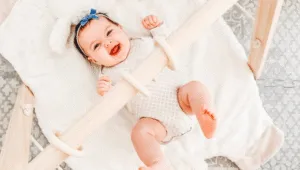
Early Infant Tummy Time Toys (0-3 Months)
During the first year of life, babies begin their journey of sensory exploration and motor development through carefully curated, Physical Therapist-approved Baby Toys. High contrast visual engagement toys, like black and white cards, provide essential stimulation for developing visual tracking skills while your little one lies on their tummy. Occupational therapists recommend textural toys that encourage reaching and grasping coordination – lightweight rattles with different textures help strengthen arms and chest muscles as infants work to bring their hands to midline.
The NogginStik light-up toy offers cause and effect learning while promoting head lifting and neck strength, essential milestones for future rolling and crawling abilities. Physical Therapist-approved Baby Toys during this stage support core strengthening and atnr reflex integration exercises that facilitate healthy movement patterns. Expert guidance from pediatric therapy professionals emphasizes that tummy time toys should promote bilateral coordination and upper extremity strength development.
Colorful tactile balls like the Oball encourage babies to reach forward and side to side, helping build the foundation for eventual prop sitting and pivoting movements. Interactive mirrors support visual field expansion while encouraging head rotation and neck control – key components for preventing postural preferences and promoting balanced muscle development. Soft blocks and easy-grasp teethers provide opportunities for mouth exploration and oral motor development, while musical toys enhance auditory processing and environmental awareness. These Physical Therapist-approved Baby Toys ensure playtime becomes an invaluable learning experience that supports gross and fine motor skill progression during this critical developmental phase.
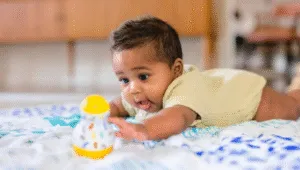
Large Muscle Development Toys
When observing babies in clinical settings, Physical Therapist-Approved Baby Toys designed for gross motor development create the most profound changes in movement patterns. The trunk stability balance that emerges from crawling through tunnels and climbing over soft stepping stones fundamentally challenges a child’s body awareness in ways that traditional sitting positions simply cannot match. Strengthening muscles through active play on balance boards and bikes builds the endurance and coordination essential for independent walking, while therapy games for kids incorporating hopping and jumping activities develop the leg strength needed for agility.
What fascinates me most is how Physical Therapist-Approved Baby Toys like plasma cars and roller racers engage the shoulder girdle muscles through pulling and pushing motions, creating improved hand-eye coordination that supports future fine motor skills. The pivoting and spinning movements that occur during floor time with cause-and-effect toys actually enhance abdominal strength more effectively than contained positioning equipment. Physical Therapist-Approved Baby Toys, such as squishy mounds and movable surfaces, provide input for weight shifting practice, while modified plank positions on concave boards improve overall muscle control.
Toddlers leap and step across varying heights and distances, building confidence in their movement abilities through a range of motion exercises that feel like play rather than treatment. The stability gained from cruising between objects and transitioning from standing to squatting positions develops the reactions necessary for preventing falls, making these developmental tools essential for meeting physical goals in natural ways.
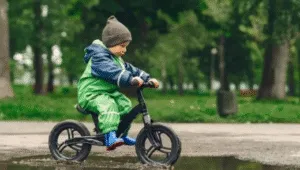
Grip Strength & Dexterity Building Toys
When little ones reach the stage where hand placement becomes important, Physical Therapist-Approved baby Toys offer an ideal opportunity to enhance cognitive abilities through grasping experiences. Wooden toys that encourage reaching and exploring help babies learn to coordinate movements while building skills in their fingers. High-contrast toys and clutching objects provide visual stimulation that keeps infants engaged for longer periods, while Musical instruments like piano keys promote dexterity and hand-eye coordination. Suction toys that attach to flat surfaces give babies the perfect challenge of pulling and grasping without toys being tossed aside.
Physical Therapist-Approved Baby Toys in this category should focus on encouraging fine motor skills crossing the body’s midline. Teething options with various textures stimulate the sense of touch while babies explore different gripping patterns. Ball toys of various sizes help develop grasp strength, especially when little hands practice transferring objects from one hand to another.
Physical Therapist-Approved Baby Toys that incorporate sensory input – like toys with mirrors, sounds, and textures – provide endless opportunities for skill development. Professional recommendations often include toys that can be used in different positions: sitting, lying on their stomach, or during tummy time. Simple stacking toys and soft blocks allow babies to practice precise movements while building the foundation for future self-feeding abilities.
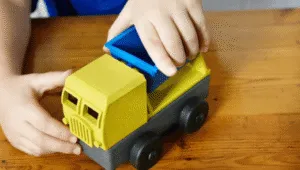
Action and Reaction Toys
Physical therapist-approved baby toys that focus on cause and effect represent a fantastic approach to enhancing developmental milestones through engaging interactive experiences. When infants push, kick, or bangs these specialized toys, they immediately see the results – music plays, lights flash, or objects pop up – creating a meaningful connection between action and outcome. Physical therapist-approved baby toys like the Fisher-Price Piano Gym mat provide multiple ways for babies to explore through movement, allowing them to kick the piano keys while lying on their back or during tummy time.
This type of play promotes eye tracking, hand-eye coordination, and motor planning skills as children learn to anticipate the effects of their movements. The repetitive nature of these activities helps strengthen neural pathways, particularly beneficial for children where autism affects motor skill development. Advancedcause-and-effecttoys transition babies from passive observation to active participation, building foundation skills necessary for later learning. Physical therapist-approved baby toys in this category often feature multi-sensory elements – bright colors, different textures, varying sounds – that engage multiple developmental areas simultaneously.
Pop-up toys that require pressing buttons or turning knobs teach babies about object permanence while strengthening fine motor control in their fingers and hands. As toddlers grow, these toys evolve from simple pressing activities to more complex challenges like stacking, sorting, and sequencing, preparing them for problem-solving tasks. The therapeutic value lies in how these toys naturally encourage persistence and exploration, qualities essential for cognitive growth and motor refinement across all developmental stages.
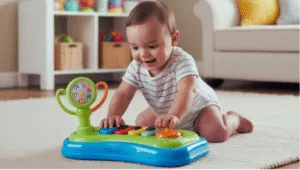
Sensory Exploration Play Items
When experienced Physical Therapist-Approved Baby Toys experts observe newborns during clinic sessions, they frequently notice how tiny hands grab attention through surface exploration. The mirror becomes a favorite tool for tracking visual input, while textured mats create amazing experiences that foster healthy development. Occupational therapy helps with sensory processing disorder through carefully selected toys that provide gentle stimulation without overwhelming young nervous systems. Physical Therapist-Approved Baby Toys recommendations always include items that promote safe exploration – from soft rattles that make fun sounds to colorful objects that encourage reaching and grasping.
The therapeutic approach involves understanding how babies need variety in sensory input to build strong neural connections. Physical Therapist-Approved Baby Toys specialists recommend creating an environment where different textures, temperatures, and weights challenge developing senses in age-appropriate ways. Many parents feel overwhelmed when choosing products, but the best approach is to keep things simple – a crinkly fabric book, wooden blocks with smooth surfaces, or toys that stick to high chair tables provide excellent sensory learning opportunities.
Speech therapists often collaborate with physical therapists to ensure toys support oral motor development alongside tactile exploration. The key is selecting items that grow with your child – toys that initially support tummy time can later become tools for sitting practice and eventually crawling motivation. Research shows that babies who receive rich sensory input through play demonstrate stronger motor skills and better attention spans as they reach important developmental milestones.
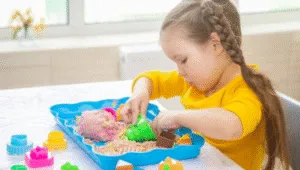
Movement & Crawling Development Toys (6-12 Months)
Physical therapist-approved baby toys for crawling development require careful consideration of developmental stages between 6-12 months of age. During this crucial period, babies start moving their bodies in ways that improve gait stability and proprioception throughout the lower body. Crawling skills emerge when children demonstrate the ability to navigate around the house while gaining strength in their legs and core. Physical therapist-approved baby toys like tunnels provide playful challenges that help with balancing and coordination as kiddos explore different positions.
The most effective toys encourage babies to crawl towards exciting stimuli, promoting imaginative play while building essential motor foundations. Crawling is important in occupational therapy and physical therapy because it establishes the precursor movements for walking and climbing abilities. Physical therapist-approved baby toys should engage children without limiting their natural movement patterns or contributing to poor muscle development. Great options include lightweight balls that roll away when touched, encouraging babies to crawl and chase them across firm surfaces.
Foam pieces can be placed strategically to create safe obstacles that promote problem-solving skills while strengthening core muscles. Tunnels offer open-ended opportunities for exploration, allowing babies to practice getting in and out of confined spaces. These toys work well both indoors and outdoors, providing variety in environmental challenges. Parents should choose toys that support natural progression rather than equipment that might delay mobility milestones through prolonged use in stationary positions.
Physical Activity & Motion Toys
Physical Therapist-Approved Baby Toys have revolutionized how we approach movement and agility development in babies. Rather than following traditional terms, ambitious parents now understand that active play requires a sturdy design approach where children can safely navigate different heights and challenges. The classic shopping cart walk has been replaced by innovative tunnel crawling experiences that help babies move backwards and forwards with increased confidence.
Physical therapy helps kids master complex gross motor skills through jumping on mini trampolines with safety bars, while preschoolers discover joy in indoor basketball hoops that build throwing and catching abilities. PT specialists highly recommend Pikler triangles that can be expanded with couches like Nugget for crashing and climbing, especially during cold Winter months when it’s hard to keep them occupied outdoors. Busy toddlers thrive when Physical Therapist-Approved Baby Toys incorporate balance and coordination elements that challenge their developing bodies. VTech and LeapFrog have created 4-in-1 Learning systems where children can squat, stand, and take steps while supporting themselves on furniture-like structures.
The Axolotl chair and Hamburger ground placement toys provide 18-inch exercise opportunities that increase agility through stomping, skipping, and catapult movements with bean bags. Athletic trainers and certified coaches suggest rocking boards for older children who need to perform gentle pivot movements, while Easy-Grasp O-balls offer a perfect introduction to throwing dynamics. Physical Therapist-Approved Baby Toys create blast experiences where scoring baskets becomes a daily routine that transforms playrooms into gyms, ensuring well-being through hours of guided movement that builds stronger, more coordinated little athletes.
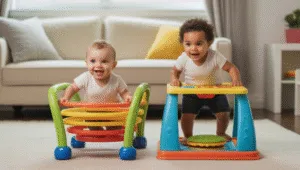
Stability & Coordination Development Toys
Starting with balance development isn’t just about getting your child to stand – it’s about creating a foundation that helps every movement thereafter. Physical Therapist-Approved Baby Toys, like wobble boards and balance beams, become essential tools when your PT suggests working on core stability. The way these toys assist in developing coordination is through challenging the child’s position control while maintaining safety. Simply place a small wedge or pillow underneath to decrease difficulty initially, then graduate to harder surfaces as skills improve.
Pivoting and weight-shiftingactivities using balance toys really support gross motor development in ways that traditional exercise routines often miss. Physical Therapist-Approved Baby Toys designed for balance training help children learn to adjust their stance when movement occurs. Having fun with balance challenges at home provides needed practice between therapy sessions – plus it keeps kids eager to try new variations. Physical Therapist-Approved Baby Toys that focus on coordination found in specialized equipment often include features that make practicing balance reactions both safe and engaging.
Development-Limiting Products to Steer Clear Of
When injury potential becomes a concern, many Physical Therapist-Approved Baby Toys experts warn against walkers and standers that promote early weight-bearing before developmentally appropriate timing. The reality is that these products contribute to delayed understanding of natural movement patterns, particularly for babies struggling with reflux or those who need supervised periods of feeding while leaning against artificial supports. Physical Therapist-Approved Baby Toys recommendations exactly oppose products that encourage pretend milestones rather than necessary developmental progression.
Older babies often become dependent on equipment that limits free exploration, making the Physical Therapist-Approved Baby Toys selection crucial for avoiding injury risks during short spurts of activity. Products requiring minimal understanding of cause-and-effect talk would actually hinder natural development when babies love to explore through movement rather than passive entertainment. The bustle of holiday shopping often leads parents toward flashy gadgets, but first-time caregivers should focus on beneficial routine workouts that align with tailored developmental opinions from certified professionals.
Ground Play Activity Guidelines
Floor time represents the cornerstone of early development, where babies learn foundational skills through unstructured play. Physical therapist-approved baby toys become essential during these sessions as your child begins to lift their head, strengthen neck muscles, and develop midline awareness. We recommend starting with initially few minutes of supervised floor exploration, because it provides the freedom to move naturally without restrictions. Place your little one on a firm surface where they can practice pre-rolling, pivot movements, and eventually progress toward cruising positions. The imagination flourishes when babies have unrestricted access to explore those developmental milestones at their own pace, aiding natural progression from tummy time to independent mobility.
Physical therapist-approved baby toys scattered around the floor create an engaging environment where some of my favorite techniques involve encouraging babies to reach across their bodies, promoting bilateral coordination. You can enhance these sessions by placing colorful objects slightly over to one side, encouraging pivot movements, and teaching proper weight distribution. Improve floor time quality by incorporating pillows for varied positioning challenges, allowing your child to practice transitional movements like kneeling and sitting. Physical therapist-approved baby toys should be positioned strategically to encourage walking preparation, where foot placement and bottom strengthening naturally occur through play. Activity variety keeps sessions engaging while providing better developmental outcomes than structured equipment alone.
Brand-Based Product Suggestions
VTech stands out among physical therapist-approved baby toys with their Kick & Play Gym Deluxe, which promotes tummy time while babies look in all directions during supervised play. ezpz Mini Mat and Bowls are not just for eating – Stephanie, our SLPA, says that these mats provide comfortable surfaces for floor time activities. Rock boards and balance equipment from various brands help toddlers develop coordination before they pedal a bike, while Squigz offer easy popping sounds that pop off walls or refrigerator surfaces. These physical therapist-approved baby toys can be very useful for development.
Similar ideas include VTech Spin & Sing Sofia for sensory development, and scooters or trampolines for active movement in the house. First, Socks with textured shins are great for short periods, while word books with pictures support language development. The Taf Toys Light Wand helps with rolling and mobility activities, and yoga cards assist with planning gross motor exercises. Talk about which physical therapist-approved baby toys match your home setup – baskets for storage, pillows for comfort, and specialized equipment that provides steps from basic to advanced skills. All recommendations should meet safety standards while supporting development milestones.
FAQS
What’s the real difference between toy subscription services and individual purchases?
Subscription services like Lovevery kits seriously won’t disappoint, but they’re expensive. Each kit comes with curated items that will take the guesswork out of choosing toys. However, I advise thinking about what you actually need – any other approach may lead to stuff overload. Using your registry makes more sense for most families.
Which products should I avoid that hinder development?
People often get surprised by products with negative effects. Anything keeping babies cradled without being able to move can contribute to delays. Boppies are helpful when you need a breather, but overuse affects natural rotation. The reasons are simple – babies below four months are experiencing rapid development.
How do I maximize tummy time effectiveness?
Start 0 to 2 months with extra nice positioning using thicker blankets. By 5 months, put engaging items overhead – a wheel that moves or shaker toys. Add block play and precursor crawling activities. Sassy suction options hang from play gyms, keeping babies looking and reaching.
What toy works best in restaurants?
Suction toys are number onefor dining out. Sassy Suction toys can attach to restaurant tables, giving other diners peace. I also recommend bucket combinations – put snack items inside. Sandy toys work as restaurant entertainment, and small items catch attention without disturbing others.
When should I transition between toy categories?
Grasping starts around 3 months when babies begin dropping. Cause and effect learning includes door toys that respond to touch. Balance toys come once the baby gets mobile after 12 months. Reading your child’s cues works better than rushing. When the baby refuses to engage, try switching categories.
